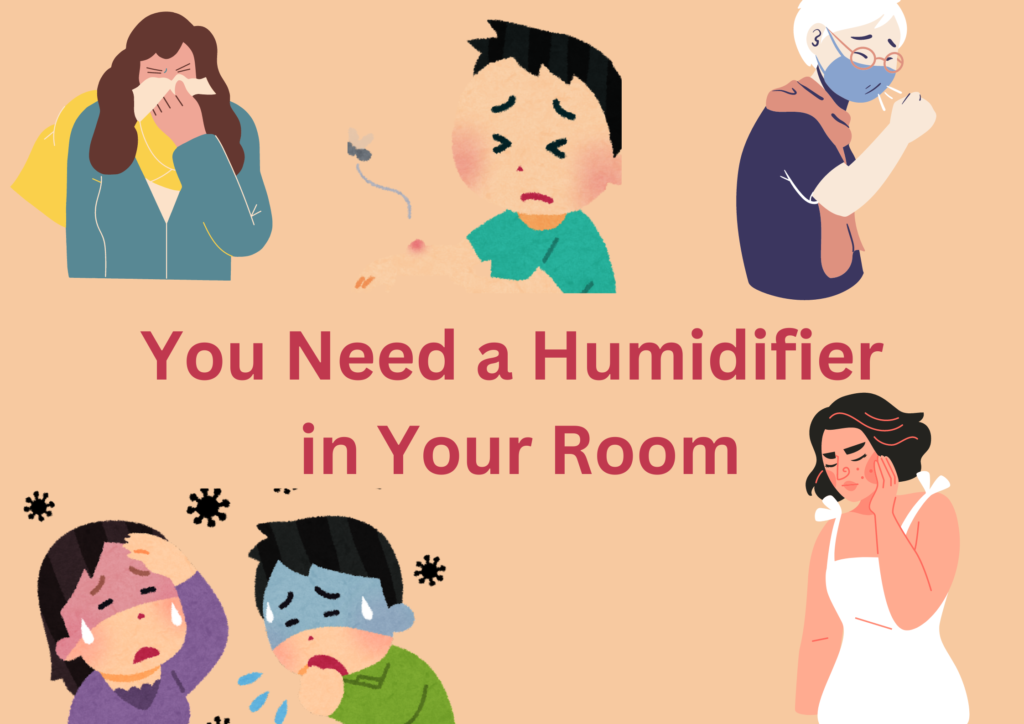If you are constantly suffering from a bloody nose, cracked lips, colds, cough, flu, or congested nose due to dry surrounding air then you must know about the importance of adding a humidifier in your home, or room. Humidifiers offer several health benefits and can help soothe these familiar problems that occur due to dry indoor air.
So, when do you need a humidifier? This article explains several important points about the requirement of a humidifier in a room or the entire home.
Importance of Humidifier
Humidity can be defined as the amount of moisture in the air. When the humidity in the air decreases, the air becomes dry. Dry air irritates many parts of the body. A humidifier is a device that adds moisture to the air. It keeps the humidity level of a room or an entire home at a recommended value.
According to United States Environmental Protection Agency ,the humidity level of the surrounding air should be maintained within a range of 30% to 50%. At this level, the surrounding air is free from dust mites, mildew, and other organisms making you feel comfortable. Healthy air leads to a healthy body. So, using a humidifier adds several health benefits to the body.
Several types of humidifiers are available in the market such as evaporative humidifiers, ultrasonic humidifiers, steam vaporizers, central humidifiers, impeller humidifiers, etc. Nowadays humidifiers integrated with advanced technologies are available that operate automatically to keep the humidity of the air at the recommended level.
What Is Relative Humidity?
The relative humidity of air is calculated by dividing the amount of water vapor in the air by the amount of moisture the air can hold at a given temperature.
Relative Humidity=
(Amount of water vapor in the air(g/m^3))/(Amount of moisture the air can hold at a given temperature (g/m^3))×100
When Do You Need a Humidifier?

In the dry winter months
When the temperature drops in winter, the moisture level in the air also decreases below the optimal level, leading to dryness in the air. Dry air causes irritation in many parts of the body. Using a humidifier in your room or home will enhance your comfort level, improve health conditions, prevent dry skin and hair, etc.
Protects from Cold and Flu
In dry air, there are more chances of spreading influenza and flu viruses rapidly. Airborne pathogens are more agile in dry air. Adding a humidifier in a room will significantly decrease the spreading of these viruses. A humidifier adds moisture to the air and this increases the relative humidity level of the environment.
According to a journal published in the Clinical Infectious Diseases higher relative humidity level can decrease the spreading of airborne virus particles by 50%. Thus using a humidifier in winter months can protect you from cold and flu.
Reduces snoring
While sleeping the facial and throat muscles of a person relax, thus restricting the airways. These problems become severe because dry air causes inflammation and irritation in nasal passageways. This leads to louder and more frequent snoring. A humidifier adds moisture to the surrounding air and reduces its dryness level. Thus, sleeping with a humidifier by your side gives a better sleep to everyone.
Prevents dry skin and scalp
The dry air pulls moisture away from the exposed skin and scalp. This makes your skin dry, itchy and irritated. Adding a humidifier increases the moisture level of the room and it helps keep your skin soft, moisturized, and hydrated.
Reduces allergy symptoms
When the humidity level of your room decreases below 30%, this is considered low humidity. Low humidity means less moisture or dryness in the air. Dry air causes allergy symptoms like stuffy nose, itchy throat, nasal congestion, etc. A humidifier adds extra moisture to the room and helps in reducing irritation in the airways. It reduces the amount of mucus produced in the body and keeps your congestion clear.

Regions with arid climates
If you are living or, planning to move to a place with an arid climate, then the dry air may cause serious problems to your health. But this problem has a very easy and affordable solution. If you are planning to stay in places with arid climates for more than 5 years you should consider installing a central humidifier in your home. If you are staying here for a short period then you should buy a humidifier for your bedroom or living room.
The dry air can make the mucus membranes in your respiratory system dry which causes irritation and itchiness in your throat and nasal passageways. This will make you feel discomfort and can leave you significantly more vulnerable to the common cold, influenza, etc. This can also make your eyes, skin, and throat dry, itchy, and irritated.
In places with arid climates, the installation of a humidifier can help you protect your health. It emits water vapor into the surrounding environment and maintains its humidity at a recommended level. It reduces the dryness of the surrounding air and protects your health from getting affected due to dry air.
Homes with poor ventilation
A home with a good ventilation process brings fresh, clean, and good-smelling air. It removes stuffy-feeling, moist, or, contaminated air. If your house has a relatively low humidity, you should use a humidifier which adds moisture to the air. It maintains the humidity at the recommended level and keeps the air fresh, healthy, and comfortable.
Humidifiers are generally used in homes to prevent colds, flu, cough, and nasal congestion. If any of the young or old people in your home are affected with lung diseases or other respiratory problems like allergies, or asthma, then a humidifier will be the best addition to your home. It also avoids cracks in paintings, furniture, peeling wallpaper, static electricity, etc.
Offices with centralized heating and cooling systems

A healthy workspace in an office leads to an efficient and productive business. The surrounding environment of a workspace is generally kept air-conditioned in summer and heated in winter. These workplaces suffer from low humidity without the installation of suitable humidifiers. An office environment with less relative humidity will cause itchy eyes, and skin, premature drying out of contact lenses, sore throat, dehydration etc. The chances of transmission of airborne viruses are higher in dry air.
Large offices install industrial humidifiers within the central air conditioning or heating system to maintain the optimal humidity level. These types of humidifiers are known as central humidifiers. Central humidifiers are usually integrated into the air conditioning system or heating system.
The water used by this device for generating moisture is supplied directly by the household plumbing or, water supply system. Inside a central humidifier, there is either a rotating drum, humidifier pad, or a steaming system that distributes water into the air. When the water evaporates into the air, the moisture or humidity level of the air increases.
So offices with centralized heating and cooling systems use humidifiers to maintain the optimal humidity level of the surrounding air.
How do you practically check the humidity level of a room?
You can check the humidity level of a room by using 3 methods.
- You can practically check the humidity level of a room by using a hygrometer. This is the easiest method to measure the humidity level and temperature of a room.
- You can also check the humidity level of a room by implementing a wet and dry bulb thermometer method. In this method first measure the dry thermometer temperature and note it down.
Then wrap a wet piece of cloth around the bulb of the thermometer and place it in a room in which you want to measure the humidity level. After 5 minutes measure the temperature of the thermometer. Now subtract the dry thermometer temperature and wet thermometer temperature and get the depression value. Use an online calculator to find out the relative humidity level of that room by using the depression value.
3. Another method to check the humidity level of a room is the ice cube method. Take two or three ice cubes with water in a glass and leave it for 5 minutes. If the glass is dripping with condensation it indicates that the humidity level is high. If there is no condensation at all then it indicates that the humidity level is low and the air is dry.
Conclusion
Humidifiers are used for maintaining an optimal humidity level in a room or an entire house. These devices are mainly used in dry winters and offer increased comfort, prevent colds and flu, reduce snoring, prevent dry and itchy skin, and avoid allergic symptoms. People living in arid climates also prefer humidifiers to create healthy surrounding air.
In large offices and industries, humidifiers are integrated with air conditioning systems or heating systems to create a healthy workspace for employees. But proper cleaning and maintenance of a humidifier is very important. Before buying a humidifier check the humidity level of your surrounding air and select accordingly.
FAQS
- When should you put a humidifier on?
Hydrometers are used in both winter and summer. When the temperature drops in winter the air becomes dry and the humidity level decreases. Whenever your home’s hygrometer reads below 40% you should turn on your humidifier. A humidifier adds moisture to the air and increases its humidity level.
2. At what temperature do you need a humidifier?
When the outdoor temperature becomes 0 to -20 degrees Fahrenheit or, below -20 degrees Fahrenheit the approximate indoor humidity level ranges between 30% to 15%. The temperature at which the humidity level falls below 30%, you will need a humidifier. The relative humidity level of the air can be measured by using a hygrometer.


23 thoughts on “When Do You Need a Humidifier? 8 Common Signs”